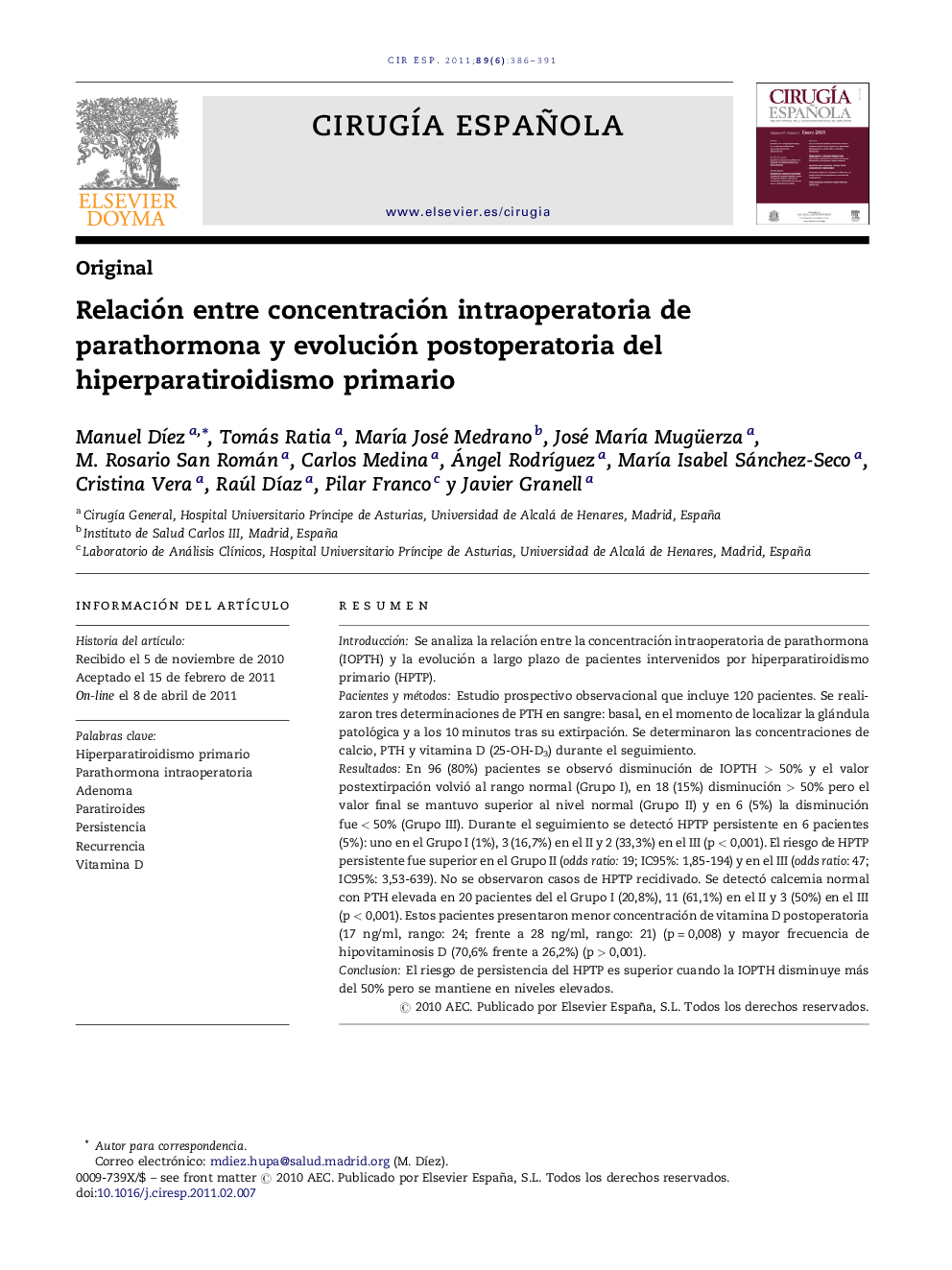| کد مقاله | کد نشریه | سال انتشار | مقاله انگلیسی | نسخه تمام متن |
|---|---|---|---|---|
| 4253049 | 1284257 | 2011 | 6 صفحه PDF | دانلود رایگان |

ResumenIntroducciónSe analiza la relación entre la concentración intraoperatoria de parathormona (IOPTH) y la evolución a largo plazo de pacientes intervenidos por hiperparatiroidismo primario (HPTP).Pacientes y métodosEstudio prospectivo observacional que incluye 120 pacientes. Se realizaron tres determinaciones de PTH en sangre: basal, en el momento de localizar la glándula patológica y a los 10 minutos tras su extirpación. Se determinaron las concentraciones de calcio, PTH y vitamina D (25-OH-D3) durante el seguimiento.ResultadosEn 96 (80%) pacientes se observó disminución de IOPTH > 50% y el valor postextirpación volvió al rango normal (Grupo I), en 18 (15%) disminución > 50% pero el valor final se mantuvo superior al nivel normal (Grupo II) y en 6 (5%) la disminución fue < 50% (Grupo III). Durante el seguimiento se detectó HPTP persistente en 6 pacientes (5%): uno en el Grupo I (1%), 3 (16,7%) en el II y 2 (33,3%) en el III (p < 0,001). El riesgo de HPTP persistente fue superior en el Grupo II (odds ratio: 19; IC95%: 1,85-194) y en el III (odds ratio: 47; IC95%: 3,53-639). No se observaron casos de HPTP recidivado. Se detectó calcemia normal con PTH elevada en 20 pacientes del el Grupo I (20,8%), 11 (61,1%) en el II y 3 (50%) en el III (p < 0,001). Estos pacientes presentaron menor concentración de vitamina D postoperatoria (17 ng/ml, rango: 24; frente a 28 ng/ml, rango: 21) (p = 0,008) y mayor frecuencia de hipovitaminosis D (70,6% frente a 26,2%) (p > 0,001).ConclusionEl riesgo de persistencia del HPTP es superior cuando la IOPTH disminuye más del 50% pero se mantiene en niveles elevados.
IntroductionThe relationship between the intra-operative concentration of parathyroid hormone (IOPTH) and the long-term outcome of patients intervened due to primary hyperparathyroidism (PHPT).Patients and methodsA prospective observational study was performed with 120 patients. Three determinations were made of PTH in blood: baseline, when the diseases gland was located, and 10 minutes after its extirpation. The calcium, PTH and vitamin D (25-OH-D3) levels were measured during follow up.ResultsA decrease in IOPTH > 50% was observed in 96 (80%) patients, and the post-extirpation value returned to the normal range (Group I), in 18 (15%) a decrease of > 50% but the final value remained higher than normal (Group II) and in 6 (5%) the decrease was < 50% (Group III). Persistent PHPT was detected during follow up in 6 patients (5%): one in Group I (1%), 3 (16.7%) in II and 2 (33.3%) in group III (P < .001). The risk of persistent PHPT was higher in Group II (odds ratio: 19; 95% CI: 1.85-194) and in Group III (odds ratio: 47; 95% CI: 3.53-639). There were no cases of recurrent PHPT. A normal calcium with an increased PTH was detected in 20 patients of Group I (20.8%), 11 (61.1%) in II and 3 (50%) in III (P < .001). These patients had a lower concentration of post-operative vitamin D (17 ng/ml, range: 24; compared to 28 ng/ml, range: 21) (P = .008) and higher frequency of hypovitaminosis D (70.6% compared to 26.2%) (P>.001).ConclusionThe risk of persistent PHPT is higher when the IOPTH decreases more than 50% but still remains high.
Journal: Cirugía Española - Volume 89, Issue 6, June–July 2011, Pages 386–391